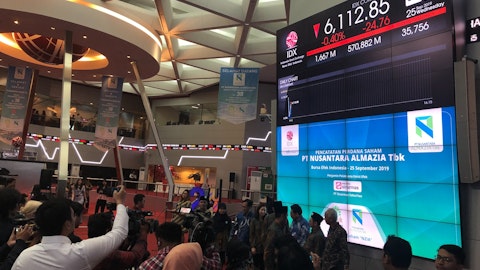RLI Corp. (NYSE:RLI) Q3 2023 Earnings Call Transcript October 24, 2023
Operator: Good morning, and welcome to the RLI Corp. Third Quarter Earnings Teleconference. After management’s prepared remarks, we will open the conference up for question and answers. Before we get started, let me remind everyone that through the course of the teleconference, RLI management may make comments that reflect their intentions, beliefs and expectations for the future. As always, these forward-looking statements are subject to certain factors and uncertainties, which could cause actual results to differ materially. Please refer to the risk factors described in the company’s various SEC filings, including in the annual report on Form 10-K as supplemented in Form 10-Q, all of which should be reviewed carefully. The company has filed a Form 8-K with the Securities and Exchange Commission that contains the press release announcing third quarter results.
During the call, RLI management may refer to operating earnings and earnings per share from operations, which are non-GAAP measures of financial results. RLI operating earnings and earnings per share from operations consist of net earnings after the elimination of after tax realized gains or losses and after tax unrealized gains or losses on equity securities. Additionally, equity and earnings of Maui Jim and the related taxes were excluded from operating earnings and operating EPS for 2022 due to the sale of RLI’s investment in the third quarter of 2022. RLI management believes these measures are useful in gauging core operating performance across reporting periods, but may not be comparable to other companies’ definition of operating earnings.
The Form 8-K contains a reconciliation between operating earnings and net earnings. The Form 8-K and press release are available at the company’s website at www.rlicorp.com. I will now turn the conference over to RLI’s Chief Investment Officer and Treasurer, Mr. Aaron Diefenthaler. Please go ahead whenever you are ready.
Aaron Diefenthaler:
Craig Kliethermes: As Todd will touch on shortly, the quarter’s results were significantly impacted by this catastrophe. Our claim team, both in Hawaii and other parts of the country, responded quickly to assess the damage and remain dedicated to helping affected policyholders begin to recover as quickly as possible. Our purpose is to take on and diversify risks that can’t be borne by an individual or business in exchange for a premium. Subsequent to a catastrophic or unexpected event, we execute our mission to fulfill the promises we’ve made to our impacted policyholders. Our financial strength is a benefit to those affected as well as our shareholders. I will let Todd and Jen to go into more detail on the financials and the market in general. Todd, take it away.
Todd Bryant: Thanks, Craig. Good morning, everyone. Yesterday, we reported third quarter operating earnings of $0.61 per share. The quarter’s results were adversely affected by losses from the Hawaii wildfires, but remain positive with an overall combined ratio of below 100 and continued growth in investment income. All in, we posted a combined ratio of 98.7% for the quarter, now 88.0% year-to-date. We continue to experience top line growth up 11% in the quarter, which Jen will unpack in a bit. Investment income advanced 50% as improved reinvestment rates and a larger invested asset base have been accretive. Operating cash flow remained strong at $329 million year-to-date, and continued to support growth in invested assets. Q3 net earnings per share of $0.29 is challenging to compare to last year’s $9.61, as 2022 was heavily influenced by the realized gain achieved on the sale of our stake in Maui Jim.
Our underwriting profitability, the previously mentioned investment income growth and modest realized gains of $7 million were partially offset by net unrealized losses on equities of $25 million in the quarter. From an underwriting income perspective, the quarter’s 98.7% combined ratio compares to 97% reported last year as catastrophe activity affected both periods. Losses recorded from the Maui wildfires were $66 million for the quarter, which was on the lower end of our previously announced range. Of this amount, $14 million relates to reinstatement premiums on our catastrophe treaties. Impact from this event added 17 points to the quarter’s combined ratio. We also recorded $5 million in other storm-related losses in the quarter. The comparative quarter last year included $40 million in losses from Hurricane Ian.
As a reminder, first dollar retention on our catastrophe treaties increased to $50 million in January of 2023, up from the $25 million previously. Apart from catastrophe events, incurred losses in the Property segment were low for the third quarter of 2023 and remain well contained for the year. Elevated catastrophe losses certainly made a notable impact on the Property segment’s loss ratio, but revenue growth is also part of the story. Earned premium growth from rates achieved over the trailing 4 quarters continue to moderate the overall impact of storm losses, with the Property segment’s combined ratio at 88% on a year-to-date basis. From a prior year’s reserves perspective, casualty drove the majority of the overall benefit recorded. Casualty posted $22 million of favorable loss emergence across a number of product lines.
Executive products, commercial access, general liability and personal umbrella had notable benefits over multiple accident years. Property was modestly adverse on the 2021 accident year. This was largely driven by Marine, which remains favorable on a current year basis. For surety, favorable reserve development was $1 million, driven by the Commercial segment. As noted each quarter, our approach to reserving remains the same and the quarter’s results are reflective of a consistent process for evaluating loss reserves. Moving to expenses. Compared to last year, our quarterly expense ratio decreased 1.2 points to 39.2%. The decline would have been greater, but for the aforementioned reinsurance reinstatement premiums. These ceded premiums are fully earned as recorded and result in lower net premiums earned from a trend perspective.
The elevated ceded premiums earned adversely impact expense ratio comparisons. For the quarter, the expense ratio was up 1.8 points due to this impact. On a year-to-date basis, the impact was 0.5 point increase. We have, however, continued to increase investments in people and technology to support growth, improve the customer experience and drive long-term efficiencies. Turning to investments. Capital Markets had a challenging quarter with both stocks and bonds declining, resulting in a total return of minus 1.7% for the combined portfolio. High-quality fixed income dominated our purchase strategy for some time, and yields averaged 5% in Q3, well above the portfolio’s current book yield. Our cash and short-term investment allocation was down from June 30 as claim activity and the repayment of our 2013 long-term debt issue at RLI Corp.

A smiling couple walking hand-in-hand out of a modern insurance office, illustrating the company’s commitment to its customers.
required additional liquidity. A portion of the proceeds used for bond repayment on September 15 were sourced by drawing $50 million from our existing credit facility at PNC. Overall, the balance sheet is in solid shape, with an increased allocation to high-quality fixed income, slightly lower leverage and strong available liquidity. Incorporating fixed income declines in comprehensive earnings and adjusting for dividends, book value per share declined slightly from June 30, but remains up 13% from year-end 2022 to $28.47. Away from the traditional investment portfolio, investee earnings were up slightly when compared to the $2 million — significantly, excuse me, when compared to the last year to the $2 million in the quarter. 2022 was heavily influenced by transaction-related expenses at Maui Jim, and as referenced in our press release, we have excluded Maui Jim’s impact on operating earnings, which offers a better comparison.
All in all, a solid operating quarter and continued positive momentum for the year. And with that, I’ll turn the call over to Jen.
Jennifer Klobnak: Thank you, Todd. I will jump right into some details on our business by segment. Property premium for the quarter was up 26%. The growth continues to be led by our E&S Property division, which grew 39% and included a 42% rate increase. The Catastrophe market remains hard with opportunities on both hurricane and earthquake business. Capacity has been reduced or pulled from many MGA markets and binding facilities. The delegated authority markets are still competitive, but only when the risk meets their narrower appetite. We are starting to see some limited competition return from admitted markets. Commercial businesses in Florida are increasing deductibles or buying less limit to control their spend. We are controlling our exposure by continuing to sell lower limits and managing our concentrations by region to acceptable levels.
Our growth, which is driven predominantly by rate at this point, has positively contributed to the bottom line. Our Hawaii homeowner book grew premium 17% in the quarter. We’ve been a stable market with local underwriting and claim channels supporting Hawaii homeowners for over 25 years. The Lahaina wildfire in August was an extreme tragic event for our insurers, producer partners and employees. We mobilized immediately after the event, providing direct support, including alternative housing and care packages within the first week. Given the severity in Lahaina, many locations were complete losses, which allowed us to quickly fulfill our promise and pay covered claims expeditiously. We continue to work with insurers to understand the totality of their loss and help them secure long-term housing.
We are committed to the Hawaii homeowners market, and we’ll continue to write new business in the state. We are proud of our associate owners’ response to this event and their ongoing commitment to provide exceptional customer service. Our Marine division had slower top line growth in the quarter due to market dynamics and underwriting adjustments made. However, we see continued opportunities in all of our property markets in the near-term — near to medium term. The combined ratio for the quarter for our Property segment was 122% due to the Hawaii losses, but the combined ratio year-to-date is 88%, which reflects the increased margins we’re achieving in the current hard market. Turning to our Surety segment. Premium was down 2% for the quarter, but we posted an 82% combined ratio.
Contract Surety premium was down 7% for the quarter. We are in a more uncertain economic period, particularly for private sector construction, which is slowing due to higher material costs and interest rates in particular. These conditions can cause contractors to stretch to win projects, but it puts pressure on their profitability and their ability to execute. We are closely monitoring our contractors’ financial security and project backlog. We are seeing some increased claim notices and are working collaboratively with our contractors to ensure jobs are completed while closely managing claims costs. Commercial Surety premium was also down slightly. We are having broad based success in writing new business in this market, but the timing of bond renewals that shifted into the fourth quarter and the release of several sizable bonds put pressure on top line growth.
As we review the overall surety industry results, we are pleased with the profitability achieved by our surety team as we continue to focus on underwriting discipline. Casualty premiums grew 6% on a 90% combined ratio. Personal umbrella premium led the way with 33% growth, supported by the continued market disruption. As a reminder, our personal umbrella product is sold on a standalone basis, and demand is rising in those states where personal lines carriers have been pulling back on their auto or their homeowners businesses due to losses or the inability to obtain adequate rate levels. Given these issues, we work with our producer partners to manage the growth and have instituted higher underlying line requirements or have surcharged insurers who buy down their attachment points.
We have also obtained rate increases from many states, which translated into a 7% rate increase for personal umbrella this quarter. Premium in our professional services and small commercial division grew 6% this quarter as we continue to focus on serving architects, engineers and contractors through a broad product offering and value added risk management services. For our other casualty businesses, we are experiencing some challenges due to competition, consolidation of insurers in select market segments, a slowdown in construction in certain regions and revenue decreases for some transportation and construction risks. Despite these challenges, our more mature business units in casualty, transportation and in executive products are collectively flat from a production standpoint.
Rate change for the casualty segment was up 5% for the quarter, which includes a 5% decrease for executive products, which is showing some moderation, and a 10% increase in transportation as we continue to stay ahead of increasing loss costs. We would like to see the industry news of loss emergence in older accident years drive more discipline within the market overall. As referenced, there are several moving parts in casualty, but we continue to focus on risk selection, with a constant eye towards underwriting profit. Once again, we are very pleased with the performance of our product portfolio, and we see positive momentum in several key areas going forward. Our diverse portfolio is supported by outstanding service to our producer partners and insureds, continues to perform well.
Now I will turn the call over to the moderator to open it up for some questions.
See also 32 Landlocked Developing Countries and 20 Most Dangerous Illegal Drugs Right Now.
Q&A Session
Follow Rli Corp (NYSE:RLI)
Follow Rli Corp (NYSE:RLI)
Operator: [Operator Instructions] Our first question today comes from Greg Peters from Raymond James. Greg, your line is now open. Please go ahead.
Gregory Peters: Great. Good morning, everyone. I wanted to go back, Jen, during your comments on pricing in casualty. I think you said 7% in umbrella, but you also called out financial products and some of the other lines where pricing is flat or down. Can you spend a minute and just give us your view on how these pricing trends are matching up with your expectations around loss cost inflation?
Jennifer Klobnak: Sure, Greg. Thanks for the question. It varies by market within the Casualty segment, our casualty book is fairly diverse. And we are seeing opportunity in a lot of stats. Personal umbrella leading the way on growth. But that is subject to approved rate filings, which we’ve had a lot of success in certain states and in other states, I’d say that it’s been more challenging. So we are managing that growth by region and working with our producers to make sure that we are not growing too quickly in states where we can’t get those approvals in place. But we think overall, based on how we’re managing that growth and based on our commitment to a dedicated claim service in that area, that we are staying on top of trends that are happening.
I know that in the industry, that is a difficult coverage. We hear that from our reinsurance partners. But as they compare our book performance to others, they continue to support us. So we think we’re doing okay in that area. I think transportation is an area that hit the news a lot recently, too. It’s related as far as the auto losses. We’ve got a 10% rate increase for Transportation for the quarter, 7% year-to-date. I’ve got a chart here that shows back to 2018, we’ve had rate increases between 6% and 12% every year consecutively. And so we continue to know that losses happen every day in our transportation division. So we need to continue to get rate of inflation, whether inflation in physical damage or bodily injury or the court system happens, we do need to continue to get rate there.
We are focused really on risk selection, that too, sell in our Transportation division in general. We’ve been shrinking in certain parts because it’s been so competitive. And so it’s not about rate versus long term, it’s about looking at the individual risks and making sure that you understand the possibility of how they are controlling losses, how they’re training their drivers and maintaining their trucks and things of that nature. So we dig into the details there. And then I think the other area of interest usually is our executive products group, which includes the D&O area. I mentioned the 5% rate decrease for the quarter, 6% year-to-date. The headlines there have been that it’s been a drastic reduction. Yes, we did see some larger reductions in the first half of the year.
But again, we’ve used risk selection to get off of accounts where we think that rate decreases too much. And so come back to individual underwriting and looking at the risk and making sure that we are comfortable with each one going forward. The momentum of renewing an account is pretty strong. But as an underwriter that’s paid on the bottom line, they take a moment and they look at it to see what is that risk has changed since the last renewal. And should they actually continue even if there is a rate decrease. And sometimes the answer is yes. That account has performed well, and we can keep supporting them. And at other times, we have to be able to walk away. And so that’s kind of the scenario. If you have questions on any of the other areas, I’m happy to answer any other questions on that.




